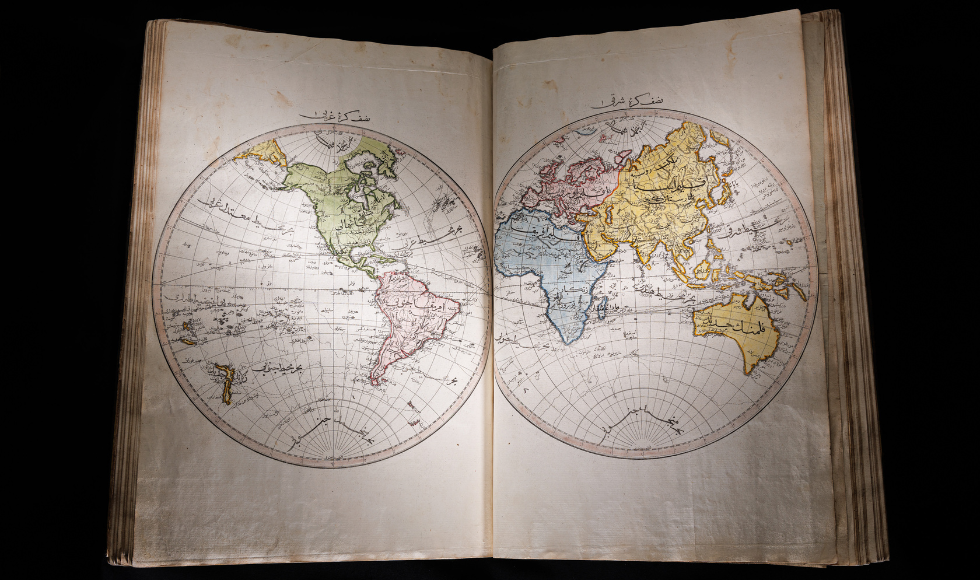Libraries and McMaster Museum of Art collaborate on new exhibition

The Cedid Atlas Tercümesi will be at the heart of the exhibition and features lavish hand-coloured engravings of maps encompassing the whole world and is captioned in Ottoman Turkish calligraphy.
McMaster University Libraries is partnering with the McMaster Museum of Art to host an exhibition that will feature rare books, maps, and antiquities related to the history of the Mediterranean.
The Great Sea: Mediterranean Imaginaries from Antiquity to Modernity, open at the McMaster Museum of Art from April 1 to August 1, 2025, will feature materials from the university libraries’ William Ready Division of Archives and Research Collections, its Lloyd Reeds Map Collection, and the museum’s own collection of related antiquities.
The exhibition has been curated by Myron Groover, archives and rare books librarian at McMaster University Libraries, and Spencer Pope, associate professor and graduate advisor in McMaster’s Faculty of Humanities.
We spoke with Myron and Spencer about what visitors can expect, the inspiration behind the project, and the work that went into making the exhibition a reality.
What inspired the exhibition and its theme?
Myron: Over the last few years, we have made some major acquisitions that are situated in Mediterranean history and the broader idea of a Mediterranean world. In particular, I’m thinking of our acquisition in 2023 of an extremely significant and rare atlas from the Ottoman Empire that was produced in Istanbul in the early 19th century. An atlas physically and metaphorically maps the world, and this got me thinking about the many contexts that are reflected in such a book: language, geography, culture, time, technology, and so on. As an object, it speaks profoundly to the idea of the Mediterranean, which means “the Mid-Earth sea” — a place where everything comes together. That idea, that region, has had such an impact on the discourses which shape our society, and our collection holds many related works which cohere in this idea of a Mediterranean world. So, the nucleus of our idea was to highlight these materials and their connections to our community.
Spencer: When Myron proposed the idea for the exhibition, I really felt it was this moment of great recognition, in which I see somebody else interested in the same material with the same themes that I am, and it’s wonderful to collaborate. One of the themes that comes up is a Mediterranean-wide perspective and looking at all of the population groups and not just some of them. Greek and Roman cultures often dominate our discussions of the ancient world, but they were just a couple of very many population groups in the Mediterranean basin. Our hope with this exhibit is to encompass all of them into the narrative rather than focusing on just a few.
What can visitors expect to see at the exhibition once it opens?
Spencer: We’ve selected a set of about 40 coins for display, which are indicative of the terrain, the population, and even a little bit of the local cultures that created them. We arranged to have an engraving with a scene of the Roman Forum, which takes us to the heart of ancient Rome, in the entry space. I match that with about a dozen coins that depict monuments from the city of Rome. There are a few ancient artifacts that accompany the coins, including a large Greek drinking cup that sets the tone for a lot of the Mediterranean exchange at the time and some Roman glass, a commodity shipped across the entire Mediterranean.
Myron: We’ll have objects that have actually passed through the hands of ancient Mediterranean peoples and were instrumental in their societies, and books that participate in Mediterranean discourse more broadly. One book which speaks to this idea of a wider Mediterranean sphere was printed in Sweden in the early 1700s. It was the doctoral dissertation of a Swedish scholar who, as part of this project, translated a Syrian geographical treatise from Arabic into Latin. This text has traveled several hundred years and several thousand kilometres to be translated from one ancient Mediterranean language into another for the benefit of an international scholarly community. I think that there’s a lot of poetry in that story. I’d like to emphasize that we don’t expect visitors to have a vast pre-existing knowledge. We’re writing descriptive captions for items on display to help give people a window into these ideas. Just bring yourself and we will bring the stories to you.
What are you each looking forward to most about the opening of The Great Sea?
Myron: I’m really excited about inviting users, not just from McMaster, but from our broader communities, into the stories that these artifacts tell, which are whimsical, tragic, chaotic, and humane. The Mediterranean story is our story, especially in a city that has large populations of current or historical immigrants from the Balkans, southern Italy, the eastern Mediterranean including Syria, and Greece. Canada in general has been shaped by a long history of engagement with France and our Latin American community, with its roots in the Spanish language, is growing. And of course, Spanish itself has borrowed a great deal from Arabic, as has Portuguese. This is our shared cultural story. This is the story of who we are and how we got to where we are.
Spencer: You know, I’d echo the excitement of presenting this to the general public and the excitement of responses from people that may have some prior knowledge, no knowledge and everything in between. This is bigger than just any one of us and there is sort of an alchemy of collaboration like this. The one thing I enjoy the most in these experiences is inviting someone to ignite a sense of discovery, and sometimes it comes from a coin right here on the McMaster campus in Hamilton.
Who might be interested in this exhibition?
Myron: I’m keen to see students, especially undergraduate students, come and engage with these materials to get a sense of what is available to them on this campus. Students of material culture, students of aesthetics, appreciators of art, persons who are interested in book history and the history of bookbinding, students of language who are interested in why we talk the way we do, would all have an interest. I think the exhibit has something for everyone, but I’m especially hoping to get younger people in, to get them up close and personal with artifacts that have traveled hundreds or thousands of years to be with them in this space.
Spencer: I’d have to agree with Myron. There’s sort of a built-in audience here at McMaster. I’ll start with students in humanities, I would encourage all of them to go. I think they’ll be met by this sort of sense of the broad Mediterranean world. If you’re a history student, this exhibition may invite you to think about Europe touching Asia, touching Africa. Even students studying sciences may have a point of entry and can look back to the beginnings of different disciplines and scientific thought, exemplified by Archimedes and Pythagoras but certainly not limited to them. I think we can see that a lot of areas on campus have connectivity back to the Mediterranean.
Tell me about the behind the scenes work that has gone into making this exhibition happen.
Myron: This exhibit has been the work of so many people. The initial idea and the preliminary curation started in the middle of last year. We’ve been working on it ever since, and this has involved a team of conservators, builders, art preparators, and students who’ve been helping us with research. So, so many people are in the mix. Spencer and I could never have done this alone. We are so grateful to be working with this amazing team.
Spencer: And the museum staff is really second to none. There’s never a moment where they’ve been thrown. Whatever the request is, they’re ready to respond and have provided innovative solutions. It’s a testament to all of their capabilities. They’re interested in taking on new tasks and pushing the museum experience forward as much as possible. I think this is another really wonderful display of McMaster’s strengths, which is expertise in a lot of different areas and willingness to collaborate.
Learn more
Learn more about the upcoming exhibition, The Great Sea: Mediterranean Imaginaries from Antiquity to Modernity on the McMaster Museum of Art website.


